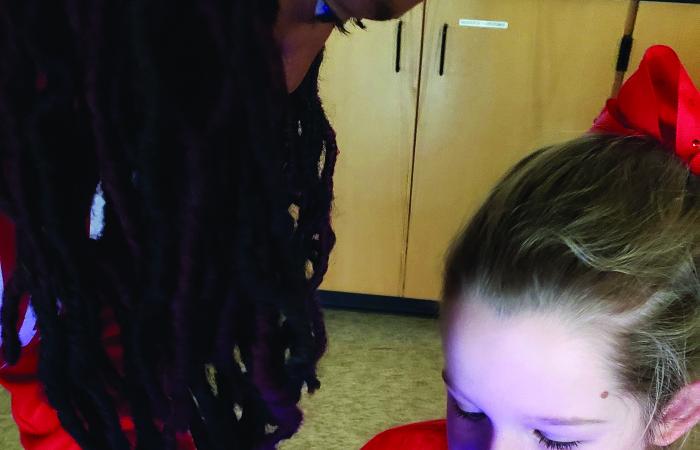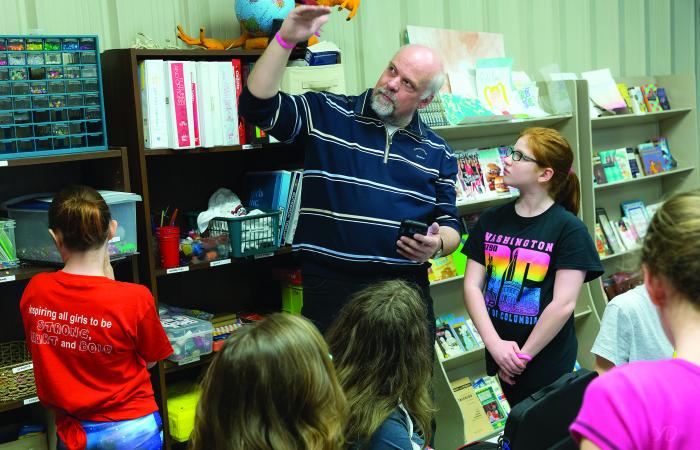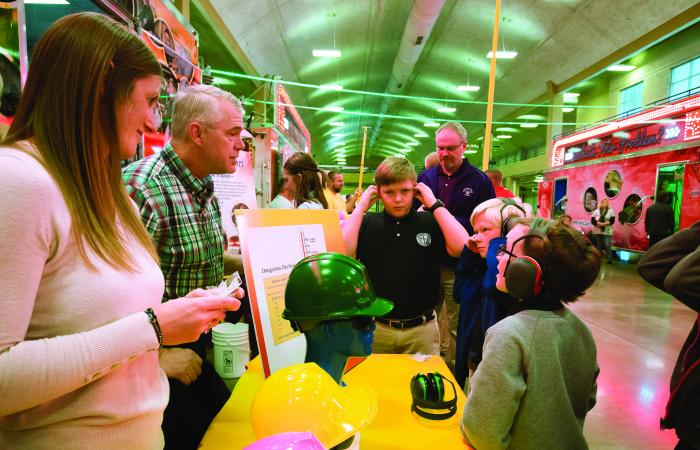The contributions of ORNL staff members in their communities range from donating to United Way and other nonprofits to volunteering for service and fundraising events with Team UT-Battelle, to—on occasion—even founding a nonprofit.
No matter the scale or complexity, their community leadership most often starts with a simple sentiment: “I want to help.”
Answering the call
That’s how Candice Halbert, a scientific associate at the Spallation Neutron Source, got the idea to start Girls in STEM, or gSTEM, a science outreach program based at Knoxville’s Vine Middle School. Halbert found herself at Vine Middle on an unrelated mission. She’d collected water and supplies—mostly from ORNL staff—to send to Flint, Michigan, during the peak of the city’s water crisis in 2016. The donation drop-off was at the school.
When she noticed that Vine is a science, technology, engineering, art and math, or STEAM, school, Halbert asked whether she could help out in a science capacity. She received an unexpected reply: Would she be willing to start a new afterschool science program for girls?
Halbert agreed, and gSTEM was born, with the mission to give girls at Vine, a majority black school, the opportunity to do hands-on experiments and to have high-level interactions with STEM professionals who look like them.
“When you ask a person the majority of the time what a scientist looks like, they’re not going to say, ‘Someone that looks like me,’” said Halbert, who notes that in her field, she often finds herself the only woman and the only person of color in a room. “So in order to change this mindset, we need more people of color, women and LGBTQ+ people in the room to associate as STEM professionals.”
The program’s success pushed Halbert to start a nonprofit, Youth Outreach in STEM, or Yo-STEM, which has tripled in size from the original eight girls and four mentors. It includes broader activities such as public STEM Saturdays and a coed Build-a-Drone program.
From the beginning, overwhelming buy-in from the Neutron Sciences Directorate’s leadership and monetary support from Team UT-Battelle helped gSTEM operate at no cost to the school, Halbert said. The mentors were then—and still are—mostly ORNL staff.
The volunteer spirit
“Recruiting volunteers when you have the lab in town is not a big problem,” said Thomas Proffen of ORNL’s Neutron Sciences Directorate, who started his own STEM nonprofit for girls.
While working with his daughter’s FIRST Lego League team, as part of an international robotics competition program, Proffen noticed that even in a setting with an equal boy–girl mix and a female coach, kids split up according to gendered tasks. After his daughter competed in an all-girls computer science competition, he decided to create a space in tech education just for middle school girls.
His idea came to life as Oak Ridge Computer Science Girls. Through the program, he hosts free coding classes every other Saturday and longer camps during school breaks. Since it started in 2017, the program has given hundreds of girls the confidence to tackle tough technical challenges. Finding volunteers never takes much more than an email to several women’s organizations at the lab, he said.
Outreach is a passion for Proffen, who also spearheads ORNL’s annual Hour of Code efforts. During a week in December, lab volunteers visit area schools to talk to students about ORNL and computer science, leading kids through hands-on coding activities designed to inspire. In 2019, 43 lab staff members visited 27 local schools.
Science for schools
Proffen is also a technical trailer lead for ORNL’s Traveling Science Fair, a unique outreach effort that gives kids across the region a chance to see firsthand the amazing science happening at ORNL through interactive exhibits held in six trailers—one each for five of the lab’s science directorates and one for mission support.
The Traveling Science Fair is where Michaela Hall, an industrial hygienist at ORNL, found her place. In addition to co-leading the mission support trailer, which represents the Facilities and Operations Directorate and the Environment, Safety, Health and Quality Directorate, Hall leads setup and safety oversight for the fair, which visits schools, festivals and events between six and 10 times a year.
Her shifts are long. Leading the setup crew means spending four to five hours setting up the day before. On the day of the fair, her team arrives two to three hours before the event begins and leaves two hours after it ends. But to Hall, it’s worth it. The fact that the Traveling Science Fair is free and mobile means it breaks down access barriers that otherwise could prevent kids from getting the kind of up-close science exposure the fair offers, especially in underserved communities.
“Those communities are the ones in my mind where you see the kids get the most excited,” Hall said. “They show up and the looks on their faces are awesome, like they are beaming with excitement.”
She’s been involved with the fair for about six years, but it was started long before that by numerous creative and dedicated ORNL staff members who made the effort possible, Hall said. Though Idaho National Laboratory has been working with ORNL staff to launch a similar effort, ORNL remains at this time the only national lab with a Traveling Science Fair.
‘Simultaneous excellence’
This type of forward-thinking outreach is just one example of ORNL management contractor UT-Battelle’s management philosophy of “simultaneous excellence” in action. The principle behind simultaneous excellence, according to ESH&Q Director John Powell, is that for the company to really achieve excellence, it must excel not only in science and technology, but also in operations and community service.
“It’s not just extra credit,” Powell said. “It’s why we’re here. If we don’t pay attention to operations and community, we might not get to even do the science.”
Powell is a leadership sponsor for Team UT-Battelle, an employee service organization that helps allocate resources and volunteers to community service efforts ranging from national park cleanups and charity races to collecting Angel Tree donations.
One dear to his heart is ORNL’s involvement with Habitat for Humanity of Anderson County, where Powell regularly volunteers. ORNL donations and volunteers showing up on Saturday mornings have helped build homes and assisted families in need with a “hand up” on vital repairs.
“But if pounding nails isn’t your thing, that’s OK,” Powell said.
The lab’s community outreach is as diverse as its more than 5,000 employees. And the best way to keep it growing, according to Candice Halbert, is to ask communities what they need and answer the call.
“We don’t want to tell people what to do,” Powell said, “but we can make it so whatever you want to do, you’re not going in alone.”—Abby Bower




